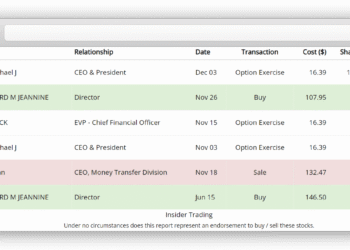Stock market performance has been a focal point for investors as they navigate the complexities of the current economic landscape. On Wednesday, the S&P 500 Index saw modest gains, climbing by 0.24%, while the Nasdaq 100 Index increased slightly by 0.05%. These movements reflect a market recovery that is influenced by various economic indicators, including a reduction in the 10-year T-note yield following the release of the FOMC minutes. Additionally, recent tariff news regarding potential 25% duties on imports may have initially caused market jitters, but the subsequent Federal Reserve discussions have provided some reassurance. As traders assess these developments, the interplay between market performance, geopolitical factors, and investor sentiment remains crucial in shaping future stock trends.
Market dynamics can significantly impact investor decisions, particularly in the context of stock valuations and economic forecasts. Recent fluctuations in the equity markets, highlighted by the S&P 500 and Nasdaq indices, illustrate the ongoing adjustments traders are making in response to external pressures such as tariff announcements and changing interest rates. The rebound in stock performance, despite initial declines due to trade policy concerns, signals a cautious optimism among market participants. Economic signals, including shifts in housing starts and building permits, further contribute to the nuanced understanding of market behavior. As we explore the intricacies of these financial movements, it becomes evident how intertwined economic factors and investor confidence are in shaping stock market outcomes.
Understanding Stock Market Performance Today
On Wednesday, the stock market exhibited a mild positive trend, as evidenced by the performance of major indices. The S&P 500 Index closed up by 0.24%, signaling a slight recovery amidst ongoing market fluctuations. Meanwhile, the Dow Jones Industrials Index and the Nasdaq 100 Index also posted gains, albeit modestly, indicating a level of investor confidence despite underlying economic tensions. This performance is crucial for investors as it reflects broader market sentiments and the potential for future growth.
The market recovery can be attributed, in part, to the recent decline in the 10-year T-note yield. Following the release of the FOMC minutes, which suggested a pause in further rate cuts, traders responded positively, reassured by the Fed’s cautious approach to monetary policy. This combination of factors has created a backdrop for a cautious yet optimistic trading environment, where understanding stock market performance becomes essential for making informed investment decisions.
Impact of Economic Indicators on Market Recovery
Economic indicators play a pivotal role in shaping market recovery, as they provide insights into the health of the economy. For instance, the recent report indicating a 9.8% drop in U.S. housing starts highlighted potential weaknesses in the housing sector, raising concerns among investors. However, the slight increase in building permits suggests a possible stabilization, which could signal a rebound in construction activity. These mixed signals can greatly influence market sentiment and affect stock performance across various sectors.
Moreover, investors closely monitor economic indicators like employment rates, inflation, and consumer confidence to gauge future market conditions. A comprehensive understanding of these metrics can help market participants anticipate trends and make strategic investment choices. As the market continues to react to evolving economic data, the interplay between economic indicators and market recovery remains a key theme for traders.
The Influence of Tariff News on Market Trends
Recent announcements regarding tariffs can significantly impact market trends, as evidenced by President Trump’s declaration of a 25% tariff on U.S. imports in key sectors like automotive and pharmaceuticals. Initially, such news led to declines in market performance, underscoring the sensitivity of investors to trade policy changes. The uncertainty surrounding tariffs can create volatility, prompting traders to reassess their positions and strategies in anticipation of potential economic repercussions.
However, market reactions can also be tempered by subsequent developments, as seen with the release of the FOMC minutes that reassured investors about the Fed’s approach to interest rates. This illustrates the complexity of market dynamics, where tariff news can trigger immediate reactions, but broader economic context ultimately shapes longer-term trends. Understanding the influence of tariff news is crucial for navigating the current landscape of stock trading.
Analyzing the Role of the Nasdaq 100 in Market Movements
The Nasdaq 100, comprising major tech companies, serves as a vital indicator of market movements, particularly in an era driven by technology and innovation. On the day in question, the Nasdaq 100 Index saw a modest increase of 0.05%, reflecting the mixed sentiments among investors. The performance of technology stocks, which are heavily weighted in the Nasdaq, often sets the tone for broader market trends, making it essential to analyze these movements for forecasting future performance.
Investors should pay attention to the unique challenges faced by tech companies, including regulatory scrutiny and market saturation. Despite the slight gains, stocks like Intel experienced more significant declines, highlighting the volatility inherent in the tech sector. Analyzing the Nasdaq 100’s performance can provide valuable insights into overall market health, helping traders make informed decisions based on sector-specific trends.
Market Recovery Amid Economic Uncertainty
As the market grapples with ongoing economic uncertainty, the concept of market recovery becomes increasingly relevant. The fluctuations in stock prices, alongside economic data releases, create a complex landscape for investors. The recent decrease in the 10-year T-note yield, in conjunction with the FOMC’s cautious stance on rate cuts, suggests a potential for recovery, even as economic indicators signal mixed results.
Market recovery is not solely dependent on favorable economic indicators; it also relies on investor sentiment and external factors such as geopolitical events and trade negotiations. The reaction of the markets to tariff news exemplifies this, where initial declines can be countered by reassuring economic policies. As traders navigate this environment, understanding the nuances of market recovery is crucial for capitalizing on opportunities.
The S&P 500: A Barometer for Investor Confidence
The S&P 500 Index serves as a critical barometer for investor confidence, reflecting the performance of large-cap companies across various sectors. Its recent gain of 0.24% underscores a tempered optimism among investors, particularly in light of mixed economic data and tariff announcements. As a widely followed index, movements in the S&P 500 can influence trading strategies and investor sentiment across the market.
Investors often look to the S&P 500 as an indicator of broader economic trends, making its performance essential to understanding market dynamics. The index’s resilience in the face of uncertainties can encourage further investment, while declines may prompt caution. By analyzing the S&P 500’s movements alongside other economic indicators, traders can gain insights into market trends and adjust their strategies accordingly.
Interpreting Mixed Market Signals
The current market landscape is characterized by mixed signals, presenting both challenges and opportunities for investors. The varying performances of major indices, such as the modest gains in the S&P 500 and the Dow, juxtaposed with the decline in the Nasdaq 100, reflect the complexities of market sentiment. These discrepancies highlight the need for investors to interpret market signals carefully to navigate potential risks.
Additionally, economic indicators such as housing starts and building permits contribute to this mixed picture. While a decrease in housing starts raises concerns about the real estate market, an increase in building permits may indicate future growth potential. Understanding how to interpret these mixed signals is vital for making informed investment decisions in a fluctuating market.
The Importance of Monitoring Bond Markets
Bond markets play a crucial role in the overall health of the financial system, influencing investor behavior and market performance. The recent increase in March 10-year T-notes, along with a reduction in yield, suggests a flight to safety among investors amid economic uncertainties. Monitoring bond market movements can provide valuable insights into investor sentiment and expectations regarding interest rates and economic growth.
As stocks and bonds often move in inverse correlation, shifts in bond yields can signal potential changes in stock market trends. The cautious approach from traders, as they absorb mixed news on interest rates and economic indicators, emphasizes the interconnectedness of these markets. Understanding the importance of monitoring bond markets can enhance investment strategies and risk management.
Future Outlook for the Stock Market
As we look ahead, the future outlook for the stock market will likely be influenced by a combination of economic indicators, geopolitical events, and monetary policy decisions. Investors will need to stay informed about ongoing developments, particularly regarding tariff news and its impact on sectors like technology and manufacturing. The cautious optimism reflected in current stock performance may hinge on the ability of market participants to navigate these challenges.
Moreover, the potential for market recovery will depend on how effectively economic indicators align with investor expectations. Traders must remain vigilant, as shifting dynamics can quickly alter market trajectories. By maintaining a proactive approach and adapting to new information, investors can position themselves for success in the evolving stock market landscape.
Frequently Asked Questions
What factors are currently influencing stock market performance, particularly the S&P 500 and Nasdaq 100?
Currently, stock market performance, including the S&P 500 and Nasdaq 100, is influenced by various factors such as economic indicators, Federal Reserve policies, and tariff news. Recent FOMC minutes indicated a pause in rate cuts, which reassured investors and contributed to a mild market recovery.
How do economic indicators affect the performance of the stock market?
Economic indicators play a crucial role in stock market performance as they provide insights into the health of the economy. For instance, a recent report showed U.S. housing starts fell, which can influence investor sentiment and expectations for market recovery. Positive indicators, on the other hand, can lead to increased confidence and higher stock prices.
What impact do tariffs have on stock market performance?
Tariff news can significantly affect stock market performance by creating uncertainty among investors. For example, President Trump’s announcement of a 25% tariff on certain imports initially caused market declines. However, the subsequent reassurances from the FOMC minutes helped stabilize the market, showing that investor reactions can vary widely based on new information.
What does recent market recovery indicate about the future of the stock market?
Recent market recovery, as seen with the S&P 500 and Dow Jones, suggests that investors may be regaining confidence despite ongoing concerns, such as tariff news and economic performance. This recovery indicates that traders are cautiously optimistic and are adapting to mixed economic indicators.
How do changes in the yield of the 10-year T-note influence stock market performance?
Changes in the yield of the 10-year T-note can greatly influence stock market performance. A decrease in yields, as recently reported, often leads to a rise in stock prices as it indicates lower borrowing costs and can suggest a more favorable economic outlook, contributing to market recovery.
| Index | Change (%) | Futures Change (%) | Key Economic News | Market Reactions |
|---|---|---|---|---|
| S&P 500 | +0.24 | +0.13 | Housing starts fell 9.8% | Moderate recovery after FOMC minutes released. |
Summary
Stock market performance showed a moderate increase on Wednesday, reflecting a cautious optimism among investors. The S&P 500, Dow Jones, and Nasdaq all posted gains as the market reacted positively to the FOMC minutes, which indicated a pause in rate cuts. However, concerns over tariffs announced by President Trump and mixed economic indicators provided a backdrop of uncertainty. As traders continue to navigate these complexities, the overall sentiment remains one of careful optimism amidst potential headwinds.













